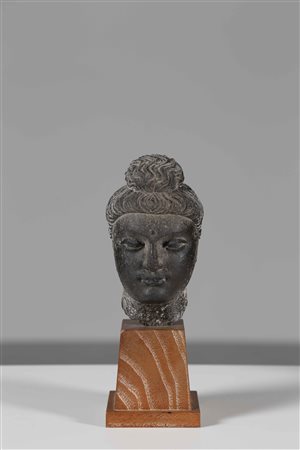 Capitolium Art - Via Carlo Cattaneo 55, 25121 Brescia
Capitolium Art - Via Carlo Cattaneo 55, 25121 Brescia
ASTA 193 - FINE CHINESE, ASIAN & ISLAMIC WORKS OF ART 3A SESSIONE
venerdì 11 dicembre 2015 ore 15:30 (UTC +01:00)
Arte Indiana Testa di Buddha Gandhara in scisto grigio Regione del Gandhara,...
Arte Indiana Testa di Buddha Gandhara in scisto grigio
Regione del Gandhara, odierni Pakistan e Afganistan, I - IV secolo AD. . Cm 14,00. Testa raffigurante Buddha Sakyamuni nella tradizione artistica della regione del Gandhara che molto ha risentito dell'influenza della tradizione artistica greca derivante dai vicini regni greco-battriani. Apollo è infatti il più diretto referente per le raffigurazioni del Buddha storico che si presenta generalmente come un giovane muscoloso con i capelli ondulati raccolti con l'ushnisha, il doppio raccolto che simboleggia la saggezza e che potrebbe essere un adattamento nel contesto buddista dell'acconciatura greca. I tratti del viso regolari, proporzionati e ben definiti comunicano il senso di pace interiore raggiunto da Sakyamuni dopo l'illuminazione. Caratteristico dell'iconografia di Buddha è l'urna, ovvero il terzo occhio al centro della fronte che allude alla spiritualità.
Retro grezzo.
Arte Indiana A Gandhara schist Buddha head
Gandhara region, todays Pakistan and Afghanistan, 1st - 4th century AD. . Cm 14,00. A head portraying Buddha Sakyamuni in the style of Gandhara region. This tradition was deeply influenced by Greek art coming from neighboring Greco-Bactrian kingdoms. In fact, the historical Buddha resembles Apollo because he is a young, muscular man with wavy hair tied with usnisa (this hairstyle symbolizes wisdom and could be a Buddhist version of the typical Greek hairstyles). His regular, symmetrical and balanced face convey the inner peace reached by Sakayumi after his illumination. Typical of Buddha's various representations is the Urna, the third eye placed in the middle of the forehead. The back of this lot is unrefined.



